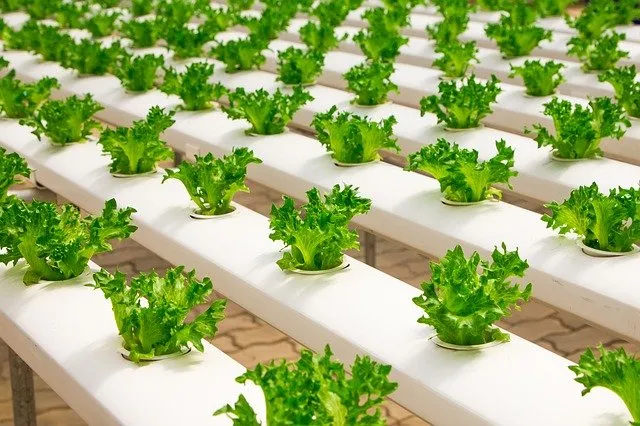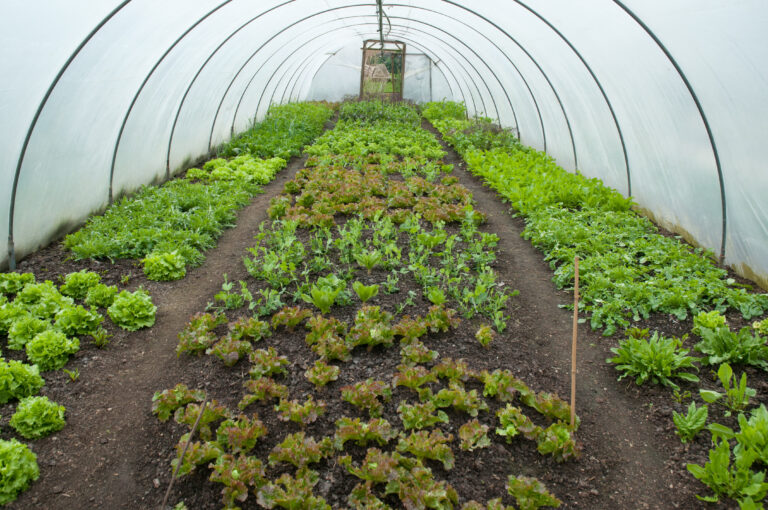Yes, you can grow lettuce year-round in a greenhouse by controlling temperature, light, and moisture conditions to simulate the desired growing environment regardless of external weather conditions.
Here are the weather conditions and essentials that the lettuce requires in the greenhouse to grow year-round.
- Light Conditions: Provide 12-16 hours of daily light with an intensity of 200-400 µmol/m²/s.
- Daytime Temperature: Maintain 60-70°F (15-24°C).
- Nighttime Temperature: Keep 50-60°F (10-15°C).
- Winter Temperature: Ensure a minimum of 45-50°F (7-10°C).
- Humidity: Maintain 40-60% relative humidity.
- Watering: Keep soil evenly moist with 1-2 inches (2.5-5 cm) of water per week.
- Mulching: Apply organic mulch to retain moisture.
Now, if you can grow lettuce all year round in a greenhouse, how to do it? Allow us to give the guidelines on how to grow lettuce all year round in a greenhouse.
Stage 1: Selecting the Right Lettuce Varieties

Growing lettuce year-round in a greenhouse requires careful selection of suitable lettuce varieties. Here’s an overview of the best choices and why they matter:
Butterhead Lettuce: Varieties like ‘Buttercrunch’ or ‘Bibb’ are ideal due to their compact growth and delicious, tender leaves. They are well-suited for limited greenhouse space.
Loose-Leaf Lettuce: Varieties such as ‘Red Sails’ and ‘Salad Bowl’ are excellent choices. They have a shorter time to maturity and can be harvested as baby greens.
Romaine Lettuce: Romaine types like ‘Parris Island’ or ‘Little Gem’ are known for their crisp leaves and can withstand slightly warmer greenhouse conditions.
Importance of Shorter Growing Cycles: Choosing lettuce varieties with shorter growing cycles is crucial for year-round greenhouse cultivation. It allows for more frequent planting and harvests.
For instance, some butterhead lettuce varieties can mature in as little as 45 days, while loose-leaf types can be ready for harvest in just 30 days.
Stage 2: Greenhouse Setup and Maintenance
Maintaining a well-structured and regulated greenhouse environment and good hygiene practices are vital for year-round lettuce cultivation success.
Here’s what you need to do to maintain an outstanding greenhouse setup.
Essential Components:
Structure: Ensure a sturdy greenhouse structure with good insulation to retain heat.
Ventilation: Install roof vents and sidewall openings to regulate temperature and humidity.
Irrigation System: Use a drip or soaker hose system for precise watering.
Shade Cloth: Provide shade during hot months to prevent overheating.
Tables or Benches: Elevate plants for better air circulation and disease prevention.
Thermometer and Hygrometer: Use these to monitor temperature and humidity.
Temperature Regulation:
- Daytime Temperature: Maintain 60-70°F (15-21°C) for optimal growth.
- Nighttime Temperature: Slightly cooler, around 55-65°F (13-18°C).
- Heaters: Use heaters during cold months to prevent frost damage.
Ventilation:
- Use natural ventilation (roof vents and sidewall openings) to control temperature and humidity.
- Install fans for air circulation to prevent fungal issues and ensure even growth.
Irrigation:
- Water consistently, but avoid overwatering.
- Drip irrigation or soaker hoses provide efficient and precise watering.
Fertilization:
- Apply a balanced, water-soluble fertilizer with an N-P-K ratio of 10-10-10.
- Administer fertilizer at half-strength every 2-3 weeks to prevent over-fertilization.
Cleanliness and Hygiene:
- Regularly remove dead or decaying plant material to prevent disease.
- Disinfect tools and equipment to avoid the spread of pathogens.
- Keep the greenhouse free of weeds and pests through proper management.
Stage 3: Optimal Growing Conditions
Growing lettuce year-round in a greenhouse requires precise control of environmental conditions. Here’s how to do it:
Temperature: Lettuce thrives at temperatures between 45°F (7°C) and 75°F (24°C). To achieve optimal growth, maintain a temperature of around 60-70°F (15-21°C) during the day and slightly cooler at night.
Use heaters in the winter and ventilation in the summer to regulate temperature.
Humidity: Maintain humidity levels around 50-70%. This prevents excessive moisture, which can lead to diseases. To increase humidity, use a humidifier or water trays. To reduce humidity, provide proper ventilation.
Light: Lettuce needs 12-16 hours of light daily. When natural light is limited in winter, use supplementary lighting systems.
LED grow lights are energy-efficient and can provide the specific light spectrum lettuce requires for growth. Place them 12-18 inches (30-45 cm) above the plants, adjusting the duration to meet the required light hours.
Stage 4: Nutrient Management and Watering Techniques
Essential Nutrients: Lettuce requires essential nutrients for healthy growth. These include:
- Nitrogen (N): 100-150 ppm
- Phosphorus (P): 25-50 ppm
- Potassium (K): 150-200 ppm
- Calcium (Ca): 100-200 ppm
- Magnesium (Mg): 50-100 ppm
Fertilization Techniques:
- Use a balanced, water-soluble fertilizer in the lettuce plant with a ratio close to 10-10-10 for N-P-K (nitrogen-phosphorus-potassium).
- Apply the fertilizer at half-strength, usually every 2-3 weeks. Adjust the frequency based on plant growth and leaf color; darker green indicates sufficient nitrogen.
- Avoid over-fertilization, which can lead to nutrient imbalances and poor lettuce quality.
Nutrient Solutions:
- Hydroponic or soilless cultivation methods can be highly effective for greenhouse lettuce.
- Consider using a complete hydroponic nutrient solution designed for leafy greens.
- Monitor pH levels (around 5.5-6.5) and electrical conductivity (EC) to ensure optimal nutrient uptake.
Watering Methods:
- Lettuce prefers consistent moisture. Water your lettuce plants when the top inch (2.5 cm) of soil feels dry to the touch.
- Drip irrigation or a soaker hose is essential to provide water directly to the root zone while avoiding wetting the foliage.
- Mulch the soil with organic materials like straw or wood chips to retain moisture and reduce weed competition.
Stage 5. Pest and Disease Management
The pest is the plants’ primary enemy, whether within the greenhouse or out of it. So, You must take preventive measures for pest and unknown plant disease management before it gets too late.
First off, you’ll need to identify the common pests and the disease for prevention.
Common Pests:
- Aphids, whiteflies, and spider mites can infest lettuce in greenhouses.
- Cutworms, slugs, and snails may also pose a threat.
Common Diseases:
- Downy mildew and powdery mildew are common fungal diseases that can attach to lettuce.
- Bacterial leaf spots and damping-off can also be problematic.
Preventative Measures:
- Regular Monitoring: Check plants often for signs of pests or diseases. Early detection is key.
- Proper Sanitation: Keep the greenhouse clean and remove plant debris promptly to reduce hiding spots for pests and disease pathogens.
- Biological Controls: Use beneficial insects like ladybugs or parasitic wasps to control aphids and whiteflies.
- Neem oil or insecticidal soap: Apply these organic solutions to combat aphids and spider mites.
Integrated Pest Management (IPM):
- Employ IPM strategies, which combine various methods to minimize pesticide use.
- Rotate crops and practice crop diversity to reduce pest build-up.
- Use row covers to prevent pest access to young plants.
Stage 6: Harvesting and Continuous Yield

Harvesting:
- Harvest lettuce when the leaves are mature but before they bolt (go to seed) for the best flavor and nutritional value.
- Leaf lettuce can be harvested when the outer leaves reach about 4-6 inches (10-15 cm) in length.
- Head lettuce should be harvested when the heads feel firm, usually 55-75 days after planting.
Continuous Yield:
- Maintain a consistent supply of lettuce by practicing proper planting schedules.
- Succession Planting: Plant small batches of lettuce seeds or transplants every 2-3 weeks.
- Ensure a variety of lettuce types (e.g., romaine, butterhead, leaf) are planted to diversify your harvest.
FAQs
What temperature is ideal for year-round lettuce cultivation in a greenhouse?
Keep the greenhouse temperature between 45-75°F (7-24°C) to ensure lettuce growth throughout the year.
Do I need additional lighting for year-round lettuce in a greenhouse?
Yes, additional lighting is typically needed for year-round lettuce cultivation in a greenhouse, especially during winter when natural daylight is limited.
What type of soil is best for greenhouse lettuce?
A well-draining potting mix with good moisture retention is ideal for greenhouse lettuce. Adding compost can improve soil fertility.
How often should I water greenhouse lettuce?
Water the greenhouse lettuce when the top inch of soil feels dry, typically 1-2 times a week, but adjust based on humidity and temperature.
What lettuce varieties are best for greenhouse growing?
Butterhead, loose-leaf, and romaine lettuce varieties are well-suited for greenhouse cultivation due to their compact growth.
Should I use organic or synthetic fertilizers for greenhouse lettuce?
Both organic and synthetic fertilizers are useful for production in greenhouse lettuce, but the choice depends on your specific preferences and goals, as both types have their advantages and considerations.
But the organic fertilizers are more effective than the synthetic fertilizers.
How do I prevent pests in my greenhouse lettuce?
Regularly inspect plants and consider using natural predators or non-chemical pest control methods like neem oil or insecticidal soap.
Can I grow lettuce hydroponically in a greenhouse?
Yes, hydroponic systems are well-suited for greenhouse lettuce cultivation, providing precise control over nutrient levels.
Yes, you can grow lettuce hydroponically in a greenhouse, and it provides precise control over nutrient levels.
What is the best greenhouse design for year-round lettuce production?
A well-insulated and ventilated greenhouse with temperature and humidity control mechanisms is ideal for consistent lettuce growth throughout the year.
Conclusion
In conclusion, growing lettuce all year round in a greenhouse allows individuals to have a continuous supply of fresh, flavorful, and sustainable lettuce right at their fingertips.
With the ability to control temperature, light, and other environmental factors, homegrown lettuce in a greenhouse ensures optimal growing conditions.
Enjoying the benefits of homegrown lettuce not only enhances the overall taste and quality of meals but also promotes self-sufficiency and reduces reliance on store-bought produce, leading to a more sustainable and rewarding gardening experience.

